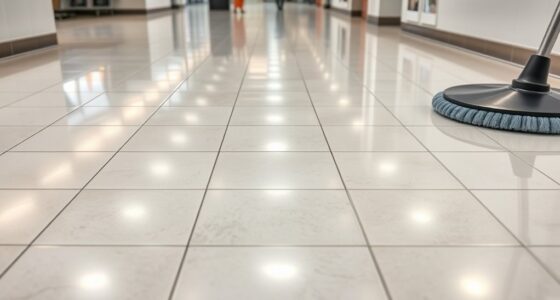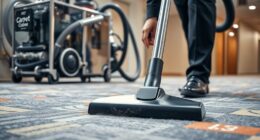Post-construction cleanup is challenging because stubborn dust and debris settle everywhere, often hiding behind appliances and inside vents. Regular cleaning tools won’t cut it—you need HEPA vacuums and damp cloths to trap tiny particles. Disposal of hazardous materials and debris requires careful effort and proper disposal methods. Ensuring good indoor air quality means thorough cleaning of hidden spots and HVAC systems. Keep going to discover expert tips for making your space truly spotless.
Key Takeaways
- Renovation dust is fine, sticky, and often hidden, making comprehensive cleaning difficult without specialized tools like HEPA vacuums.
- Dust and debris settle into hard-to-reach areas such as vents, behind appliances, and under cabinetry, requiring detailed inspection.
- Regular cleaning methods are insufficient; damp cloths and microfiber tools are necessary to trap residual dust effectively.
- Proper disposal of hazardous materials and recyclable debris is crucial for safety and environmental compliance.
- Ensuring indoor air quality involves thorough cleaning of HVAC systems and hidden spots to prevent dust circulation.

After completing renovations, thorough cleaning is essential to remove dust, debris, and lingering residues that can affect your home’s safety and appearance. Renovation projects often generate a substantial amount of dust and debris that settle into every nook and cranny. Dust removal isn’t just about making your space look tidy; it’s vital for your health, especially if anyone in your household has allergies or respiratory issues. You need to tackle dust on surfaces, in vents, and within hidden corners, making certain that tiny particles don’t continue to circulate through the air. Proper debris disposal is equally important. You should separate and discard construction waste responsibly, from broken tiles to leftover packaging. Leaving debris around can pose safety hazards and make your home feel cluttered and uninviting.
Cleaning after renovations isn’t a simple sweep and mop job. The dust you’re dealing with is often fine, sticky, and resistant to regular cleaning methods. You’ll need to use specialized tools like HEPA vacuums designed to trap microscopic particles, preventing dust from spreading back into the air. When doing dust removal, pay close attention to high-traffic areas and surfaces that you use daily. Don’t forget hidden spots behind appliances, inside vents, or under cabinetry, where dust tends to settle unnoticed. For debris disposal, consider renting a dumpster or scheduling a pickup with waste disposal services to handle large quantities of construction waste safely. Sorting debris into recyclable and non-recyclable materials helps reduce environmental impact and ensures compliance with local regulations. Additionally, ensuring proper air filtration can significantly improve indoor air quality after renovation work.
Use HEPA vacuums and check hidden spots to effectively remove stubborn dust after renovations.
A meticulous approach to post-renovation cleaning requires patience and attention to detail. Use damp cloths or microfiber mops to trap dust on surfaces rather than just spreading it around. For stubborn residues, a gentle cleaning solution might be necessary to break down grime without damaging new surfaces. Remember, dust and debris can hide in HVAC systems or behind walls, so it’s wise to have professionals perform thorough duct cleaning and inspection if you want to make certain your home is truly clean and safe. Proper debris disposal also means removing hazardous materials like old paint, solvents, or contaminated materials following safety guidelines.
In the end, a thorough cleanup not only restores your home’s beauty but also guarantees a healthier living environment. Taking the time to properly remove dust and dispose of debris prevents lingering dirt from affecting your daily life and protects your investment in your home renovation. It might seem like an overwhelming task, but focusing on these key areas guarantees your renovation project ends with a clean, safe, and welcoming space for you and your family.
Frequently Asked Questions
How Long Does Post-Construction Cleaning Typically Take?
The time estimation for post-construction cleaning varies based on the project’s size and complexity. Typically, a cleaning timeline ranges from a few hours for small spaces to several days for larger renovations. You should plan accordingly, considering dust, debris, and leftover materials. To guarantee thorough cleaning, it’s best to allocate ample time, especially if you want a spotless finish, and consult professionals for a more accurate estimate tailored to your project.
What Safety Precautions Are Necessary During Cleanup?
During cleanup, you need to prioritize safety by wearing personal protective equipment like gloves, masks, and goggles. Always conduct hazard identification first to spot potential dangers like dust, sharp objects, or chemicals. This helps you avoid injuries and health issues. Stay vigilant, follow safety protocols, and guarantee proper ventilation. By taking these precautions, you protect yourself and make the cleanup process safer and more efficient.
Can I Do the Cleaning Myself or Should I Hire Professionals?
You can definitely tackle DIY cleaning after renovations if you’re comfortable with the mess and safety precautions. However, consider professional services if the debris is extensive, involves hazardous materials, or if you lack the time and tools. Professionals bring specialized equipment and experience, ensuring thorough and safe cleanup. Weigh your skills and the project’s scope to decide whether DIY cleaning suffices or if hiring experts is the smarter choice.
What Specialized Equipment Is Used for Post-Renovation Cleaning?
Ever wondered how professionals tackle post-renovation mess? They use specialized equipment like industrial vacuums equipped with HEPA filters to capture fine dust and debris effectively. These tools guarantee thorough cleaning without spreading allergens or particles. Can you imagine trying to clean up heavy debris with regular vacuums? Investing in or hiring experts with this equipment makes post-renovation cleanup faster, safer, and more efficient.
How Do I Remove Stubborn Paint or Adhesive Residues?
To remove stubborn paint or adhesive residues, you should first identify the surface and type of material involved. Use paint removers or adhesive removers specifically designed for that surface, applying them carefully. For tougher spots, a plastic scraper or putty knife can help with paint removal and adhesive cleanup without damaging the surface. Always follow manufacturer instructions, wear protective gear, and test a small area first to avoid damage.
Conclusion
After all the dust settles and the last paint stroke is done, the real challenge begins. Will you uncover hidden debris lurking in every corner? Can you truly restore your space to its sparkling new state? The cleanup process might surprise you with unexpected surprises, but with patience and effort, you’ll transform chaos into comfort. Are you ready to face the final steps and see your renovated space shine like never before? The finish line is closer than you think.










